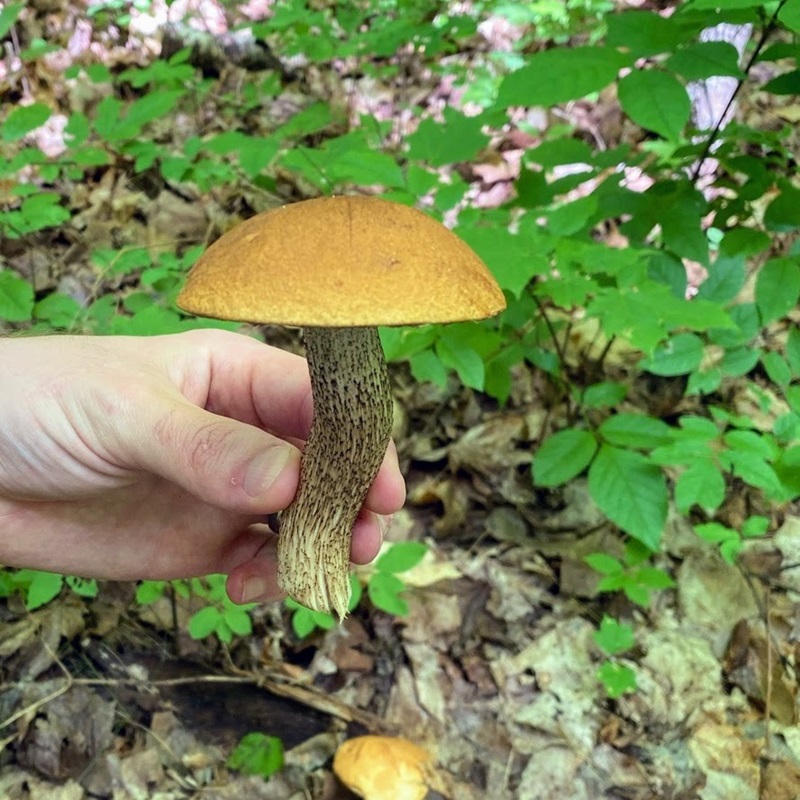The Spotlight is pulled from our weekly mushroom e-mail that features spotlight articles, interesting mushroom news, events and activities. It’s free to join the newsletter. Register here.
In today’s spotlight we’re going to keep things a bit more general and talk about “Boletes”, since they are popping up everywhere right now and they are more than worthwhile to discuss.

When I first got into foraging mushrooms I was told by my “instructor” that there were only 3 edible mushrooms. I cannot for the life of me remember what two of them were, but the third was the infamous King Bolete (Boletus edulis), also known colloquially as Porcini (Italian) and Cèpe (French). Honestly, I’m not sure whether my so-called “instructor” was even aware of the differences between King Boletes and any other type of Bolete, but alas, I will tell you that King Boletes are large mushrooms with a flared-out stem. They smell delightful and should be quite firm. Older (larger) specimens are likely to be filled with bugs as we are not the only animal looking to devour these tasty mushrooms.
Scientifically, the Bolete could be a genus (Boletus), family (Boletaceae) or order (Boletales) of mushrooms. The order contains mushrooms that most people would never refer to as Boletes, including a host of gilled mushrooms and puffballs. That discussion will be for another day.

The family Boletaceae is truly the important component here. When foragers or (most) mycologists refer to a Bolete, they are usually referring to a mushroom within the Boletaceae family. Almost every mushroom within this family have two similar characteristics: it’s a toadstool-shaped mushroom, and the undercap is made up for pores, not gills or teeth.
If you have found yourself a toadstool-shaped (cap on stem) mushroom, then you have probably found yourself a so-called “Bolete”, congratulations! Why are folks so happy to spot Boletes? Bolete mushrooms are fantastic mushrooms for beginner foragers. Of the roughly 800 species known around the world, only a handful are actually toxic, and they are typically easy to identify. As an example, Boletus subvelutipes has a brown/red cap, red pores, and a red stem. When cut it almost instantly stains blue, then turns black. Avoid that one.

If you plan to forage Boletes, it’s almost worthwhile to learn the toxic mushrooms in your region. Once you know the toxic mushrooms, you can be fairly certain harvesting mushrooms that aren’t the toxic ones. It’s much easier to learn to identify the few toxic or bitter species in the northeast then to learn the ~100 that aren’t toxic.
Once you get into foraging Boletes, you will begin to note the ones that are grouped into their own genus’. Suillus, for example, is a genus of Boletes that includes some pretty (for lack of a better word) gross mushrooms. They are really sticky mushrooms, they grow everywhere, and their flavour ranges from meh to not good. They are terrible to work with since everything sticks to them, and they dehydrate into just about nothing.

Another genus is that of Leccinum. Leccinum mushrooms have some really good mushrooms in them, and I love to use them in soups and stews throughout the winter, as they give a good firm texture and a nice mild flavour as well. However, it’s worth noting that Leccinum mushrooms, which usually have scales on the stem, have a mildly toxic compound on the skin of the cap. If ingested, you can expect very mild gastronomic upset. Cooking the mushroom will not remove the compound, but dehydrating the mushroom will remove the compound. Alternatively, you can (quite easily) remove the skin of the cap with the edge of a knife blade, peeling it from margin to center. This, too, will remove the compound.

The family of Boletes has a wide range of interesting mushrooms within it. Just take a look at the Old Man of the Woods (S. strobilaceus) as a great example. It’s worthwhile for any forager to learn their Boletes, but also, as a fundamental group of the mushroom world, anyone with an interest in fungi ought to learn about them – whether or not they plan to eat them.
My Top 10 Mushrooms course provides photos, videos, and details on finding and cooking the King Bolete, while the Top 26 Mushroom course covers 10 edible species plus the dreaded B. subvelutipes.
Interested in reading more spotlights as well as finding out about recent mushroom news and upcoming events and activities? Join our weekly newsletter! Join now.
